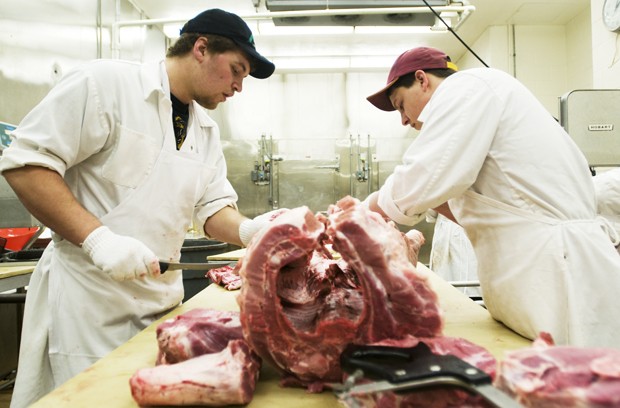On one side of the hall, animal science junior Chris Dahlke slid the frozen raw meat of a recent science experiment through the blade of a jigsaw to ready it for packaging. On the other, Marty Linden stood between two industrial-size freezers with a package of ribeye steak in one hand and bratwurst in the other, ready to buy some meat. Linden was visiting the weekly meat lab sales, put on by the University of Minnesota Department of Animal Science, where the department cuts up and sells all of the usable leftover meat from their weekly experiments. Located in the Andrew Boss Laboratory of Meat Science on the St. Paul campus, the sale offers meat harvested for various educational purposes âÄî which, after approval from the Minnesota Department of Agriculture, is sold to the public. âÄúWe definitely canâÄôt use everything after itâÄôs been in the classroom,âÄù said lab supervisor Pete Nelson. Nonetheless, the lab harvests enough meat to steadily offer an assortment of almost 150 kinds of patties, steaks, roasts and tenderloins from 2 to 5 p.m. every Wednesday. The sale dates back to 1977 when the Meat Science Building became the nationâÄôs first meat laboratory. All profits go to the Department of Animal Science and to the funding of the meat sale itself. Nelson said this weekendâÄôs Easter holiday âÄî as with most holidays âÄî has brought the lab more orders of ham and lamb. In the classroom, animals are sometimes used up to seven times and often vary in quality. Nelson also lends himself as a teacher to the student employees who make up the staff, a majority of whom are animal science majors. Student employees are responsible for grinding up and processing the lower-quality meat to make sausages. These students also cut the meat off the carcasses, often at 6 a.m., and prepare the meat for sale. âÄúClass is a lot of sitting and watching,âÄù said sophomore Rebekah LaBerge. âÄúSo itâÄôs great to get hands-on experience.âÄù While the sale does not seek to compete with for-profit businesses, Nelson said, the focus on customer service and quality could rival any other local butcher. âÄúWe focus on consistency and quality,âÄù said Nelson. âÄúIf a customer wants to come in on a day other than Wednesday, we try to accommodate that âĦ Our prices are competitive with any supermarket.âÄù LaBerge said students make up about 25 percent of customers, while the rest are faculty. âÄúWe get really busy around 3 oâÄôclock when the dairy sale starts on the first floor,âÄù she said. Nelson said the saleâÄôs main promotional tool is word of mouth, and that he believes the lab has survived without major promotion thanks to the labâÄôs quality products âÄî namely their top selling item, bacon. âÄúAt the end of the day, we donâÄôt want to waste the animals,âÄù said Nelson. âÄúItâÄôs a way for the tax payers, who pay for the animals weâÄôre working on, to get a return on their investment.âÄù

Image by Matt Mead
Animal science juniors Chris Dahlke, left, and Jason Ertl, right, cut up a pig Wednesday to be sold at a meat sale in the Andrew Boss Lab.
Meat lab benefits animal science
The sale offers meat harvested for educational purposes.
by Adam Daniels
Published April 1, 2010
0

